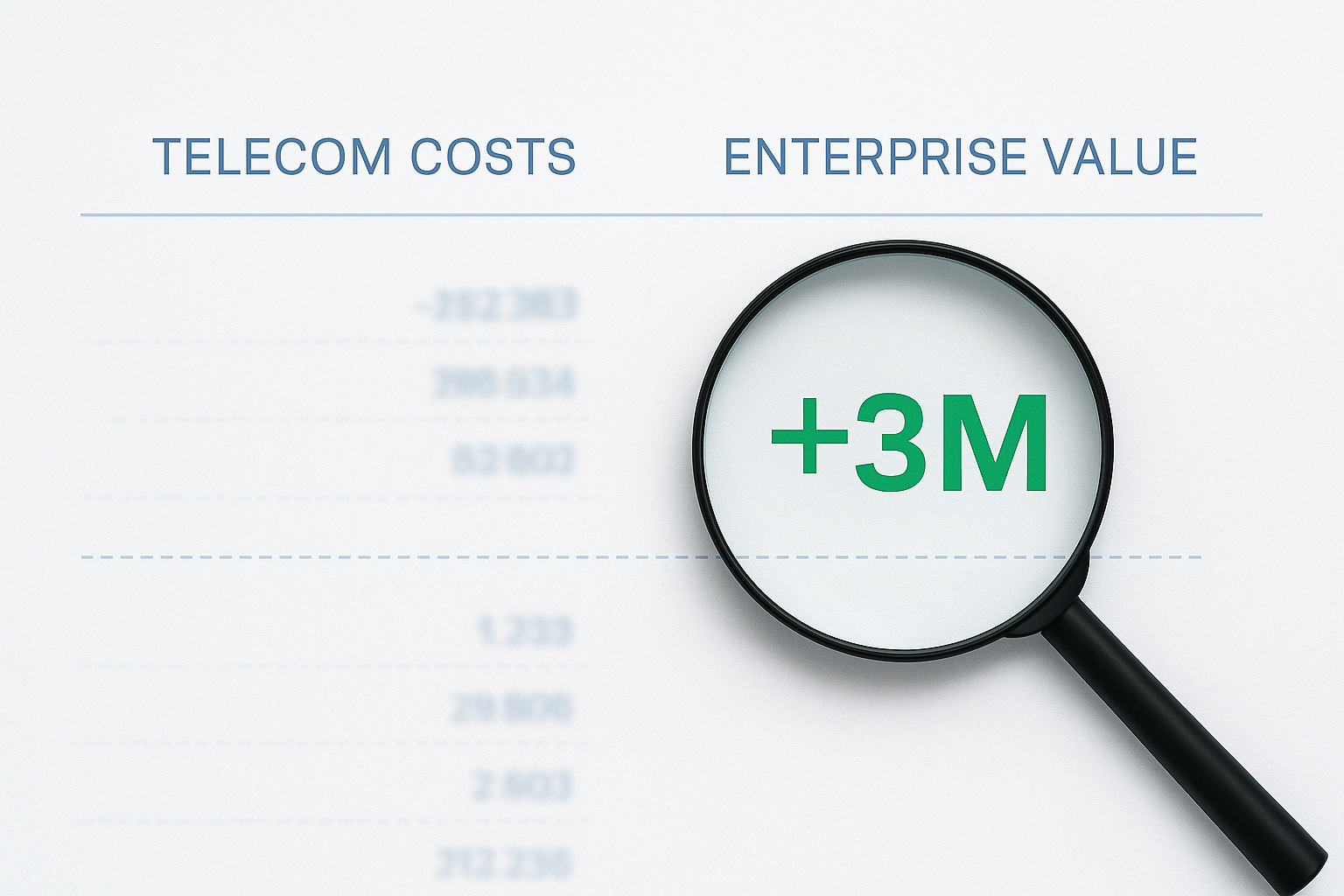Switching to a VoIP phone system is often seen as a budget-friendly move — but how much does VoIP really cost? And what are you actually paying for beyond the monthly bill? Understanding the real cost of VoIP starts with a clear VoIP cost comparison — not just with landlines, but across different service levels and providers. As more small businesses shift from landlines to cloud-based solutions, understanding the full VoIP pricing breakdown is essential.
From upfront setup fees to long-term savings and hidden expenses, this guide will walk you through everything you need to know. We’ll compare VoIP vs landline costs, break down common VoIP pricing models, and help you evaluate what features truly deliver value. If you’re planning a phone system upgrade in 2025, this article will help you make a smart, cost-effective decision with no surprises. This article provides a thorough breakdown of the VoIP vs landline cost so small businesses can make informed decisions.
VoIP Pricing Breakdown: What’s Included in the Monthly Cost?
VoIP is often marketed as a low-cost alternative to traditional phone systems — and for good reason. Monthly fees are generally predictable and far more affordable than legacy landline bills. But what exactly are you paying for when you sign up with a VoIP provider? In any VoIP cost comparison, upfront fees, hardware needs, and long-term service charges must all be factored in.
Here’s what’s typically included in a standard VoIP pricing plan:
1. Base Subscription Fee
This is the core monthly charge per user or per line. It often includes unlimited local and domestic calling, along with basic features like caller ID, call forwarding, and voicemail.
2. Advanced Features
Many VoIP providers bundle premium tools into their monthly plans — or offer them as add-ons. These can include:
- Auto-attendants and virtual receptionists
- Call analytics and reporting dashboards
- Voicemail-to-email and voicemail transcription
- Call queues and hunt groups
- CRM and helpdesk integrations
- Video conferencing and team messaging
Some providers include these features in their base tier, while others reserve them for premium plans.
3. Unified Communications Tools (UCaaS)
Modern VoIP systems often function as part of a larger Unified Communications as a Service (UCaaS) platform. If you’re paying for UCaaS, your monthly cost may also include:
- Business SMS
- Internal team chat
- File sharing
- Video and screen sharing
- Mobile and desktop softphone apps
4. International Calling Fees
While domestic VoIP calls are often unlimited, international calling usually incurs per-minute fees. These rates vary by country, so it’s worth checking the fine print if your business communicates globally.
5. Taxes and Regulatory Fees
VoIP services are subject to federal, state, and local taxes — just like traditional phone lines. Many providers add these fees separately on your bill, so your final monthly charge may be slightly higher than the advertised rate.
6. Optional Add-Ons
You may also encounter charges for optional services such as:
- Toll-free numbers
- eFax services
- Dedicated conference bridges
- Call recording storage
- Compliance tools (e.g., HIPAA-ready features)
When reviewing VoIP cost comparisons, be sure to factor in which of these elements are included, optional, or charged à la carte.
Comparing VoIP vs Landline Costs: Total Cost of Ownership
When evaluating VoIP vs landline cost, it’s important to look beyond just monthly service fees. The total cost of ownership (TCO) includes setup, hardware, maintenance, scalability, and long-term value. Here’s how the two systems stack up:
✅ Upfront Costs
VoIP:
VoIP systems have minimal upfront expenses. Most setups require only IP phones (if not using existing devices), and many providers offer plug-and-play hardware or softphone apps that eliminate the need for physical phones altogether. There’s no need to install lines or legacy PBX equipment.
Landline:
Traditional landline systems often involve significant upfront investment in hardware like desk phones, on-premise PBX systems, and wiring. Installation typically requires a technician, driving up initial costs.
✅ Monthly Service Charges
VoIP:
VoIP plans are usually flat-rate, per-user pricing. These plans often include unlimited domestic calling, bundled features, and 24/7 support. You can easily forecast costs as your business scales.
Landline:
Legacy systems may charge per line, with variable fees for long-distance calls, voicemail, call forwarding, and other basic features. Bills can fluctuate and become hard to predict — especially with higher call volumes.
✅ Maintenance and Support
VoIP:
Since VoIP is cloud-hosted, the provider handles updates, troubleshooting, and upgrades. There’s little to no need for onsite IT support or dedicated telecom staff.
Landline:
Maintaining a landline system may require contracts with a service provider for on-site repairs or PBX maintenance. As hardware ages, parts become harder to replace, and service calls can be costly.
✅ Scaling Costs
VoIP:
Adding a user is as simple as provisioning a new login or device. There’s no need to rewire offices or purchase new physical lines. This makes VoIP highly scalable — ideal for growing businesses.
Landline:
Each new employee may require new wiring, desk phones, or PBX expansion. This slows down deployment and increases your IT burden.
✅ Long-Term Value
VoIP systems deliver a lower total cost of ownership over time. You’re not just saving on equipment and service fees — you’re gaining operational efficiency, remote work flexibility, and built-in tools that reduce the need for third-party apps or IT services.
Meanwhile, landline systems offer limited features and increasingly high costs for fewer business benefits — especially in a digital-first world.
Hidden Costs to Watch Out For in VoIP Services
While VoIP is generally more cost-effective than landlines, not all pricing models are created equal. Some providers advertise low rates but bury extra charges in the fine print. To make an informed decision, small businesses need to look closely at the real VoIP pricing breakdown — including the less obvious costs.
1. Add-On Features
Some VoIP providers offer basic calling at a low price, but charge extra for essentials like:
- Auto-attendants or IVR menus
- Call recording
- Voicemail transcription
- Advanced call analytics
- CRM or help desk integrations
Before signing up, clarify what’s included in your base plan — and what costs extra.
2. Hardware and Equipment
While many businesses can use existing computers or mobile devices, others may require:
- IP desk phones or headsets
- Conference room speakerphones
- VoIP gateways for analog device compatibility
Make sure you account for any equipment needs, especially for hybrid or in-office setups.
3. International Calling Rates
VoIP calls between users on the same platform are often free, but international calling outside your region may incur per-minute charges. If your team or customers are global, check a provider’s rate sheet for transparency.
4. Tiered Pricing as You Scale
Many providers offer attractive pricing for small teams — but the rate per user can increase as you grow. Watch out for pricing tiers or minimum user requirements that might raise your bill unexpectedly.
5. Contract Terms and Fees
- Early termination fees: Canceling before your contract ends may incur penalties.
- Setup or activation fees: Some providers charge to get your system up and running.
- Porting fees: Transferring existing phone numbers might come with one-time charges.
Always review your agreement closely before committing to a long-term plan.
What You Get for Your Money: Key Features That Justify VoIP Costs
When comparing VoIP vs landline cost, it’s important to factor in what you’re actually paying for — not just the monthly price tag. VoIP systems offer significantly more functionality, often replacing multiple communication tools and saving time and money in the long run.
Here are the most valuable VoIP features that deliver ROI for small businesses:
1. Unified Communication Tools
Most VoIP platforms go beyond voice calls to include:
- Video conferencing
- SMS and team messaging
- Voicemail-to-email
- File sharing and presence indicators
These all-in-one systems reduce the need for separate subscriptions to Zoom, Slack, or other collaboration tools.
2. Automation That Saves Time
Features like auto-attendants, call routing, and voicemail transcription reduce manual tasks and streamline workflows. For example, routing calls by department or availability improves service without hiring more staff.
3. Real-Time Analytics
VoIP systems provide detailed reports on:
- Call volumes and durations
- Missed or dropped calls
- Agent performance
- Customer wait times
These insights help optimize staffing and improve service quality — a key edge for small teams with tight resources.
4. Integration with Business Apps
Top VoIP platforms connect with CRMs (like Salesforce or HubSpot), help desk systems, and productivity tools. This enables click-to-call, call logging, and better customer data access, boosting efficiency across sales and support.
5. Remote Access and Mobile Flexibility
With mobile and desktop apps, employees can take calls from anywhere — using the same business number. That’s critical in today’s hybrid work environment and a major cost-saver compared to managing desk phones or call forwarding through landline systems.
VoIP Cost Comparison: VoIP vs Landline Side-by-Side
Let’s break down the real VoIP pricing breakdown next to traditional phone systems so you can clearly see how each stacks up.
| Category | VoIP System | Traditional Landline |
|---|---|---|
| Setup Costs | Low — often plug-and-play with minimal hardware | High — requires physical wiring, PBX, tech install |
| Monthly Service Fee | $20–$40/user (flat rate) | $50+/line + long-distance charges |
| Long-Distance Calling | Usually free or included | Charged per minute or based on zones |
| International Calls | Discounted or included | Very expensive |
| Maintenance | Minimal — handled by provider (cloud-hosted) | High — on-premise tech support required |
| Feature Add-Ons | Included (e.g., voicemail, call routing) | Extra cost per feature |
| Hardware Costs | Optional IP phones; can use existing devices | Requires desk phones, wiring, PBX hardware |
| Remote/Mobile Access | Included with apps | Requires complex call forwarding |
| Scalability | Instant — add users virtually | Time-consuming and expensive |
| Downtime/Redundancy | Geo-redundant, disaster-ready | Vulnerable to outages |
Bottom Line:
Even if the monthly VoIP cost appears similar at first glance, the bundled features, scalability, and lower maintenance needs often lead to total savings of 30–60% over legacy systems. Plus, VoIP offers functionality that landlines simply can’t match — especially for remote and hybrid teams.
Hidden Costs to Watch For: What Some VoIP Providers Don’t Tell You
According to the FCC, VoIP providers must comply with key safety and reliability standards, including ensuring access to emergency services like 911. These regulatory requirements can influence service offerings and pricing structures, making it essential to consider them when evaluating VoIP providers.
While VoIP is generally more affordable than traditional phone systems, not all providers are transparent about what you’re really paying for. To make a smart investment, it’s important to understand where surprise fees or inflated costs might sneak in.
Here are some common hidden costs to watch out for in any VoIP cost comparison:
1. Per-User Pricing That Doesn’t Scale
Many VoIP providers advertise low per-user rates — but they may charge for every additional extension, voicemail box, or feature you add. If you’re scaling quickly, these costs can add up fast. Always check whether pricing includes unlimited users or if it grows linearly with your headcount.
2. Premium Features Locked Behind Tiers
Advanced features like CRM integrations, call analytics, or custom auto-attendants may be restricted to higher-tier plans. Before signing a contract, confirm what’s included in your plan — and what will require a costly upgrade.
3. International and Toll-Free Minutes
While most domestic calls are included, some VoIP providers charge extra for international dialing or toll-free minutes. If your business has international clients or uses toll-free numbers, make sure you understand those rates upfront.
4. Hardware Leasing
You might be offered free desk phones — but they could be on a lease agreement that costs more over time than buying them outright. If you’re offered hardware as part of your plan, ask whether it’s rented or owned, and compare total costs.
5. Onboarding and Support Fees
Some providers charge one-time setup fees, onboarding costs, or training services. Others may charge extra for premium support levels or 24/7 help. Look for vendors that include white-glove setup and ongoing support without hidden costs.
6. Bandwidth and Network Requirements
VoIP relies on your internet connection, so if your current bandwidth isn’t sufficient, you may need to upgrade your ISP plan or network equipment. While this isn’t a direct VoIP charge, it’s a cost that many businesses overlook.
Tip: Always request a detailed, itemized quote before signing any VoIP contract. A trustworthy provider will explain all costs upfront — and help you identify potential savings over your current setup.
How to Budget for VoIP Without Surprises
If you want to avoid unexpected charges and maximize the return on your investment, the key is to take a proactive, line-by-line approach to VoIP budgeting. Whether you’re switching from a landline or upgrading from another provider, here’s how to set a realistic and reliable budget for your VoIP system:
1. Start With a Needs Assessment
List your must-have features (e.g., voicemail-to-email, call recording, mobile access) and your nice-to-haves. This helps avoid overpaying for bundles that include tools you won’t use — or missing out on features that matter for your business.
2. Calculate Total Cost of Ownership (TCO)
Go beyond the advertised monthly price. Include:
- Setup or activation fees
- Equipment costs (buying vs leasing phones)
- Number of users/extensions
- Feature upgrades or plan tiers
- Internet upgrades if needed
- Long-distance or international calling charges
A true VoIP pricing breakdown should consider all of the above to give you a complete picture of what you’re really paying.
3. Compare Providers Side-by-Side
Use a standardized template or spreadsheet to compare different VoIP offerings. Look for:
- Per-user cost vs. inclusive pricing
- Number of included minutes
- Level of customer support
- Contract length or cancellation terms
This helps you spot where one provider might offer better value — even if their advertised monthly rate is higher.
4. Ask About Future Scalability
Find out how pricing changes as you grow. Will you need to upgrade to a more expensive plan just to add a few users? Will new locations need separate licenses or infrastructure? A provider with predictable, scalable pricing will save you money in the long run.
5. Factor in Training and Transition Time
Switching systems can temporarily affect productivity. Some businesses overlook the soft costs of downtime, retraining, or reconfiguring processes. Look for providers that offer white-glove onboarding to minimize disruption.
6. Avoid Long-Term Contracts If Possible
Month-to-month plans offer more flexibility, especially for small businesses still growing or evaluating their options. If a long-term contract is required, ask for a trial period or clear opt-out terms.
Pro tip: Some VoIP providers (like TeleCloud) offer free cost comparisons or audits to help you understand how their pricing stacks up against your current system.
Is VoIP Really Cheaper Than Landlines? A Real-World Cost Comparison
One of the most common assumptions about VoIP is that it’s cheaper than traditional landlines — but how does that actually play out in real-world business scenarios?
Let’s break down the costs side-by-side:
| Cost Category | VoIP (Cloud-Based) | Traditional Landline (PSTN) |
|---|---|---|
| Setup Costs | $0–$100 (often waived) | $500–$2,000+ (wiring, hardware, PBX system) |
| Monthly Service Fees | $15–$40/user (flat-rate often available) | $30–$60/line, plus long-distance fees |
| Long-Distance Calls | Often included or very low per-minute | Can be $0.10–$0.50 per minute |
| Hardware Requirements | Desk phones optional; use existing devices | Requires handsets, PBX equipment |
| Maintenance | Minimal; cloud-managed | On-site service calls and upkeep costs |
| Feature Add-ons | Usually included (voicemail, auto-attendant, etc.) | Often extra or unavailable |
| Scalability Costs | Add users instantly with little/no added cost | New lines often require technician visits |
| Mobility Support | Built-in mobile and remote access | Call forwarding only (often extra) |
Example Scenario: 10-Person Business
- Landline system:
- Setup: $2,000
- Monthly cost: $500+
- Add-ons (voicemail, call routing, long distance): $100–$200/month
- Total 1st year cost: ~$8,000+
- VoIP system:
- Setup: $0 (with bring-your-own-device model)
- Monthly cost: $300–$400
- All features included
- Total 1st year cost: ~$3,600–$4,800
That’s a potential savings of over 40% in the first year alone — and the difference grows over time as VoIP systems require less maintenance and scale more efficiently.
Final Verdict: What You’re Really Paying For With VoIP
VoIP isn’t just about cheaper phone calls — it’s about smarter communication investments.
According to the Federal Communications Commission (FCC), traditional phone bills often include various hidden fees and regulatory surcharges that can add up quickly.
When you factor in setup costs, long-term flexibility, built-in features, and the ability to support hybrid teams, VoIP consistently delivers a lower total cost of ownership than landlines. More importantly, you’re not just saving money — you’re gaining agility, productivity, and tools that grow with your business.
Yes, VoIP pricing can vary depending on your provider, team size, and feature needs. But when chosen wisely, the ROI is clear: modern VoIP systems pay for themselves in both dollars and performance.
A transparent VoIP cost comparison helps small businesses avoid surprise fees and understand where their money is going. Ultimately, a well-researched VoIP vs landline cost breakdown shows VoIP is often the more scalable and affordable choice.
Still weighing your options? Check out our earlier post on VoIP vs Traditional Phone Systems: What’s Best for Small Businesses in 2025?
Ready to See the Real Value of VoIP?
TeleCloud helps small businesses eliminate wasteful phone costs and get more from their communications tools. Our VoIP plans include everything you need — no surprise fees, no outdated hardware, just simple, scalable service.
👉 Contact us today for a custom VoIP cost comparison and free consultation.





